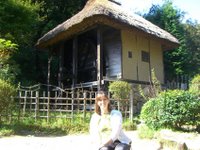 After being frustrated with Japan's drinking culture, I was ready to see something different... last Monday 10/9 was a holiday here in Japan (Taikukan, or Sports Day) and a day off of class. Though there was a festival at Takadanobaba near school, I didn't feel like spending the hour and half to get there. (I don't think I've mentioned that before... I live in Kawasaki-shi, kinda far from school... it takes 50 min-1hr 20mins to get to school, depending on if I time the train transfers right.)
After being frustrated with Japan's drinking culture, I was ready to see something different... last Monday 10/9 was a holiday here in Japan (Taikukan, or Sports Day) and a day off of class. Though there was a festival at Takadanobaba near school, I didn't feel like spending the hour and half to get there. (I don't think I've mentioned that before... I live in Kawasaki-shi, kinda far from school... it takes 50 min-1hr 20mins to get to school, depending on if I time the train transfers right.) So... with my host mother, we went to what is probably my town's only famous feature: Nihon Minkan-en, the Japan Open-Air Folk House Musuem. (Click for the website)
So... with my host mother, we went to what is probably my town's only famous feature: Nihon Minkan-en, the Japan Open-Air Folk House Musuem. (Click for the website)Traditionally styled Japanese homes are know through the world for thier unique architure. (Though I'm not an architure buff, so I don't know really WHAT is so noted...) But nowadays, there are not many craftspeople with the knowledge and skills to recreate such historic style. But thier are still s
 ome remaining homes and buildings that have withstood the test of weather, usage, and time. Those that are remaining are considered national treasures, just as the people who still practice the traditional arts of old are considered living national treasures. However, not every owner of these historically valuable homes recognized thier worth, sometimes being negligent in the care of the home. To preserve these irreplacable buildings, in 1965 my city Kawasaki-shi begain to relocate them from all over Japan to the Minka-en (民家園). They currently have 25 buildings, inc
ome remaining homes and buildings that have withstood the test of weather, usage, and time. Those that are remaining are considered national treasures, just as the people who still practice the traditional arts of old are considered living national treasures. However, not every owner of these historically valuable homes recognized thier worth, sometimes being negligent in the care of the home. To preserve these irreplacable buildings, in 1965 my city Kawasaki-shi begain to relocate them from all over Japan to the Minka-en (民家園). They currently have 25 buildings, inc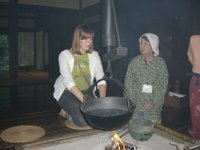 luding a family-owned soba-ya (buckwheat noodle restaurant), shrine, and a Kabuki stage, as well as displays of tools and untensils inside the homes and buildings to illustrate the lifestyle of the people who lived in them.
luding a family-owned soba-ya (buckwheat noodle restaurant), shrine, and a Kabuki stage, as well as displays of tools and untensils inside the homes and buildings to illustrate the lifestyle of the people who lived in them.Some houses you can walk almost all the way through, and some you can only look in from the outside. However, because of
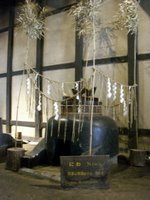 Japan's hot, humid summers, most of the homes have sliding doors that open to catch an occational breeze.
Japan's hot, humid summers, most of the homes have sliding doors that open to catch an occational breeze.There was also some cultural demonstrations by voleenters, such as basket and straw shoe weaving (not easy!), traditional cooking methods (pot over a fire), and plays at the Kabuki stage. Of course, since no Japanese museum would be complete without a place to buy snacks and a drink, you can have lunch at the soba-ya (restaurant) and get a drink from the vending machine. (They're everywhere! I think the only place I have
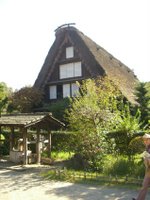 NOT seen a vending machine was at a shrine...)
NOT seen a vending machine was at a shrine...)These homes really have an aura of being well-used and well lived in... and died in. I think that I would NOT be able to spend a night in on of these drafty houses... many have a large space between the foundation and the floor and lots of attic space, space where more than just dust bunnies and moths haunt (>ロ<;)...... (hehe)
Overall, I think this open air museum is definately worth a visit.
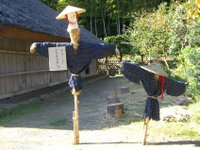

2 comments:
Claire, What a wonderful day you had. I agree, a visit here must be well worth it. Nice to see a picture of you host Mom. The sun is STILL shining! Plum-san
>>Kuma
i think before i came here, i never really thought about buying drinks, i always just brought one from home... but now i have to commute from home to school, dragging a bottle of water is a pain... but i should do it and save money, like maybe 300yen a day
>>Plum
i'm looking for the good places to take you where you come ^_^
Post a Comment